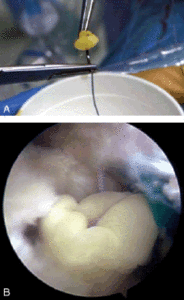Patients commonly ask about platelet rich plasma for treatment for their condition. It has been studied in the rotator cuff, elbow tendons as well as the Achilles tendon. Here is some information from AAOS.org on PRP for the rotator cuff.
Two separate randomized trials show no benefit to using PRP fibrin matrix. Improving healing after a rotator cuff tendon repair is an ongoing problem for orthopaedic surgeons world wide. In two separate studies—one European and one American—presented at the AAOS 2011 Annual Meeting, researchers found that one of the latest tools for healing injuries, platelet-rich plasma (PRP), does not make a big difference.
The results of “Platelet-rich plasma augmentation for arthroscopic rotator cuff repair: A randomized controlled trial,” were presented as a podium presentation during the AAOS Annual Meeting. Using PRP with a fibrin matrix (PRFM) provided no superior clinical or structural outcome when compared with the more traditionally, technically less demanding, and economically more advantageous technique of nonaugmented suture anchor repair.
The study included 88 patients who were randomized to two groups—one that received PRFM (Fig. 1) and one that did not. All patients had a repairable full-thickness tear of the rotator cuff and associated pathology of the long head of the biceps, but no episodes of shoulder instability or radiographic evidence of glenoid or greater or lesser tuberosity fracture.
 |
| Fig. 1 A, A platelet-rich fibrin matrix is a flat, circular membrane of autologous suturable fibrin that must be used within 30 minutes. B, An intraoperative arthroscopic image of the platelet-rich fibrin matrix interposed between rotator cuff and bone. Courtesy of Roberto Castricini, MD |
The groups were comparable in initial demographics and preoperative measures such as range of movement, strength, and pain (based on Constant scores). Sixteen months after surgery, using the same measures, researchers found no difference in scores between the two groups (Table 1). Although magnetic resonance imaging (MRI) found more evidence of rerupture in the group that did not receive the PRFM, further treatment was not necessary because the patients were satisfied with their condition.
The study does not support the use of PRFM for augmentation of a double row repair of a small or medium rotator cuff tear to improve healing, although, given the heterogeneity of PRP products on the market, it is possible that other preparations may be more effective.
Specialty Day support
Another study on 79 patients who received platelet-rich plasma with a fibrin matrix demonstrated no real differences in healing in a tendon-to-bone rotator cuff repair. In fact, this preliminary analysis suggests that the PRFM, as used in this study, may have a negative effect on healing. However, these data should be viewed as preliminary, and further study is required. The effect of platelet-rich fibrin matrix on rotator cuff tendon healing: A prospective randomized clinical study.
The randomized trial broke the 79 patients into two groups: those who received the PRFM and those who did not. Standardized rotator cuff repair techniques and postoperative rehabilitation protocols were used for all patients. The tendon healing was evaluated using ultrasound at 6 weeks and 12 weeks after surgery. Ultrasound was also used to determine blood flow in various areas of the repaired tendon. The researchers also looked at shoulder movement outcome scales and strength measurements.
Overall, we found no differences in tendon-to-bone healing between the two groups. Repairs were intact in two thirds of the PRFM group and in 80 percent of the control group. Ultrasound found no significant differences in healing at 6 weeks or at 12 weeks after surgery. Nor were there significant differences in outcome or strength measures.
The researchers agree that variability in the way platelets are recovered, platelet activation, and the mechanisms for the way the PRFM reacts with the tendon cells may contribute to the contradictory results found in other studies. He also noted that this study was unable to document the number of platelets actually delivered to patients who received the PRFM.
Additional research needs to be performed to figure out the mechanisms for why PRP is successful in healing certain areas of the body and not others. With more study we will continue to learn new procedures for improving orthopaedic surgery outcomes.
Additional Resources:
The Effect of Platelet-Rich Fibrin Matrix on Rotator Cuff Tendon Healing
Specialized Blood Plasma Treatment Does Not Improve Rotator Cuff Healing, Study Finds
Bottom Line
- Two separate randomized studies found no significant benefit to using PRFM to improve healing after rotator cuff repair.
- One study found more reruptures in the group that did not receive PRFM; the other study found more intact repairs in the group that did not receive PRFM.
- More research is needed to uncover the ways that PRFM reacts with tendons, ligaments, and bones.
Reference: AAOS Now April 2011 Issue
http://www.aaos.org/news/aaosnow/apr11/clinical4.asp
http://www.aaos.org/news/aaosnow/apr11/clinical4.asp
Thanks,
JTM, MD